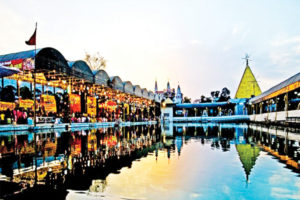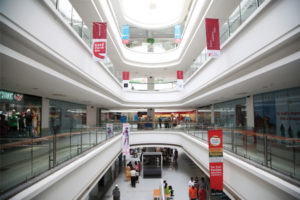

Commissioner
Jalandhar Municipal Corporation
Jalandhar is on the right track to a better future of sustainable tourism that will last through many future generations. Either establishing a destination certification programme or enrolling in an existing programme will help ensure the planning and implementation stays on the correct path of the smart tourist city of Punjab, if not the whole of India, writes Commissioner, Jalandhar Municipal Corporation, Basant Garg for Elets News Network (ENN).
“Tourism provides employment to the poorest of the poor. Gram seller earns something, autorickshaw driver earns something, pakoda seller earns something, and tea seller also earns something,” says Prime Minister Narendra Modi.
Tourist attractions have become a phenomenon of our times. Attractions and the behaviours associated with them are one of the most complex and highly structured universal codes co-creating modern communities and Smart Cities. The role of tourist attractions in the post-modern world is changing. Consumer requirements and the innovativeness of tourism organisers have led to change and evolution on the tourist attraction market, which have led in turn to this sector becoming more diversified. Tourist attractions are dynamically changing in terms of form, location, style and scale.

 Dynamically developing modern tourism has a continual need for new attractions, i.e. destinations for millions of customers who have already visited the recognised attractions. As these tourists have been everywhere, it takes a lot to impress them. A rich and versatile tourism offer (only these have any chance of standing out from thousands of others) should be based on a search for original attractions and when these are found wanting, the creation of new ones. By necessity, the creation of these primarily involves culture and technology, for the number of natural attractions is limited and those that exist have already been identified.
Dynamically developing modern tourism has a continual need for new attractions, i.e. destinations for millions of customers who have already visited the recognised attractions. As these tourists have been everywhere, it takes a lot to impress them. A rich and versatile tourism offer (only these have any chance of standing out from thousands of others) should be based on a search for original attractions and when these are found wanting, the creation of new ones. By necessity, the creation of these primarily involves culture and technology, for the number of natural attractions is limited and those that exist have already been identified.
The attractions emerging these days are tied into a new model for the evolution of tourism, the three Es (Entertainment, Excitement, Education), which has supplanted the traditional three Ss model (Sun, Sea, Sand). The emerging new attractions are meant to entertain, excite (in a sense to frighten), to raise adrenaline levels and to educate by provoking thought and reflection. Such entertainment and educational ends are served by the theme and amusement parks that have developed as a result, the most important example being Disneyland. The first Disneyland was created in California, and the next ones in Florida, Japan, Hong Kong and Paris (Euro Disneyland). Other important attractions that appeared in the second half of the 20th century include the Pompidou Centre, the Arctic Centre located by the Arctic Circle in Rovaniemi, the Greenwich Waterfront, the Oxford Story and the Smurf Park in Belgium. In India, small scale waterparks were created at various places and cites in 1990s but only Essel world near Mumbai run by Zee group is a worthwhile self sustaining entertainment destination which has added into the tourist diversity of the young tourists coming there for entertainment, fun and excitement.

Jalandhar, which is at the centre of Doaba and Punjab, and which is a NRI heartland of north India, very well connected with airports, railheads and highways and huge middle class and high paying consumers like industrial houses, huge number of educational facilities having thousands of young university students and a city in itself with population of more than one million people, needs a next entertainment and amusement park like Disneyland India, built in and around it.
“The City of Jalandhar Which is at centre of Doaba and Punjab and which is a NRI heartland of north India with population of more than one million people needs a next entertainment and amusement park like Disneyland India, built in and around it.”
 The market-based approach is a crucial element in tourism development. The core market attributes of attractions are their proximity to large cities (the primary source of tourists), accessibility, opening times, daily visitor attendance and accompanying services. On the basis of this information we can assess the quality of any attraction, paying attention to such criteria as: authenticity, uniqueness and pulling power, i.e. the number of tourists, hence the income generated by attraction managers . It might be asked which factors will influence the tourist attraction market in the future.
The market-based approach is a crucial element in tourism development. The core market attributes of attractions are their proximity to large cities (the primary source of tourists), accessibility, opening times, daily visitor attendance and accompanying services. On the basis of this information we can assess the quality of any attraction, paying attention to such criteria as: authenticity, uniqueness and pulling power, i.e. the number of tourists, hence the income generated by attraction managers . It might be asked which factors will influence the tourist attraction market in the future.
A distinction can be made between a group of factors producing the external conditions for tourism and those factors linked to tourism phenomena. The first group undoubtedly includes a group made up of political, economic, socio-cultural and technological factors (to mention the most important). In addition, changes occurring in tourism itself (internal conditions), new trends, fashions and forms of behaviour carry consequences for the tourist attraction market. One of the most important factors shaping the tourist attraction market is developments in the media, especially in social, visual and print media. (Jalandhar has an historic edge in this regard). The famous newpapers, punjabi entertainment channels, media groups and conglomerates etc.
“Jalandhar which has many renowned world class doctors and medical facilities like hospitals and lot of feeder NRI population returning home for medical treatment and procedures can be developed as hub in northern India for medical tourism and well being industry.”
Medical tourism is a growing sector in India. In October 2015, India’s medical tourism sector was estimated to be worth $3 billion. It is projected to grow to $7–8 billion by 2020. According to the Confederation of Indian Industries (CII), the primary reason that attracts medical value travel to India is cost-effectiveness, and treatment from accredited facilities at par with developed countries at much lower cost. The Medical Tourism Market  Report: 2015, found that India was one of the lowest cost and highest quality of all medical tourism destinations. It offers wide variety of procedures at about one-tenth the cost of similar procedures in the United States. Jalandhar which has many renowned world class doctors and medical facilities like hospitals and lot of feeder NRI population returning home for medical treatment and procedures can be developed as hub in northern India for medical tourism and well being industry along with facilities like Disneyland in its vicinity so that family members of patient on medical tourism can enjoy their time with less stress and more entertainment.
Report: 2015, found that India was one of the lowest cost and highest quality of all medical tourism destinations. It offers wide variety of procedures at about one-tenth the cost of similar procedures in the United States. Jalandhar which has many renowned world class doctors and medical facilities like hospitals and lot of feeder NRI population returning home for medical treatment and procedures can be developed as hub in northern India for medical tourism and well being industry along with facilities like Disneyland in its vicinity so that family members of patient on medical tourism can enjoy their time with less stress and more entertainment.
A simple policy recipe for ensuring a sustainable form of tourism development in Jalandhar can be followed by remembering six steps:
- Promote sustainable development
- Create products for specific visitor market segments like medical tourism, entertainment tourism (theme parks, entertainment etc)
- Gain and maintain competitiveness
- Enhance visitor experience (combining more than two forms of tourism like destination tourism with entertainment, medical and religious or adventure tourism)
- Preserve local resources
- Improve residents’ quality of life (more tourism- more employment avenues and opportunity-more revenue for municipal corporation-enhanced spending on citizen and Smart Cities initiatives of Jalandhar district). South Carolina state in USA has developed around only as entertainment and attraction tourism as industry.
By keeping these steps in mind, a destination Jalandhar is on the right track to a better future of sustainable tourism that will last through many future generations. Either establishing a destination certification programme or enrolling in an existing programme will help ensure the planning and implementation stays on the correct path of the Smart tourist city of Punjab, if not the whole of India.
Be a part of Elets Collaborative Initiatives. Join Us for Upcoming Events and explore business opportunities. Like us on Facebook , connect with us on LinkedIn and follow us on Twitter, Instagram.











